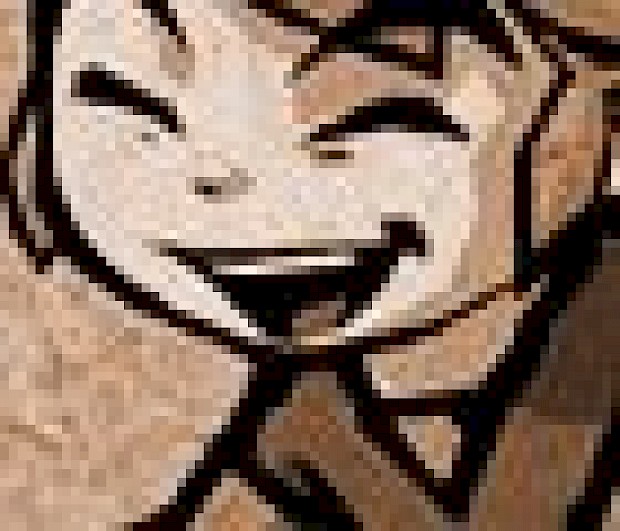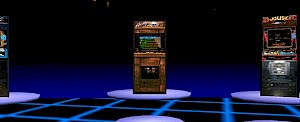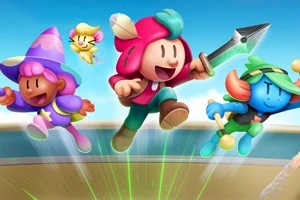Feature: A Celtic Link

Posted 09 Nov 2005 at 11:20 by guest

| "The Celtic imagery of this legend, the way the story is retold through an ancient scroll seemingly translated from a Hylian language, is simply inspired." |
One of the greatest controversies in recent gaming history began with Nintendo's decision to utilise cel-shading for The Legend of Zelda. Given the often-hostile response to 2003's The Wind Waker, it is unlikely that Nintendo will take such a chance again and has played it safe with a forthcoming return in Twilight Princess to the "realistic" look of N64 classic Ocarina of Time. So much has been written about the bold, colourful graphics of Link's last GameCube adventure that a related aspect of The Wind Waker has never been given the credit it deserves: and so the Celtic designs contained within this interpretation of Hyrule are long overdue for consideration!
The introductory sequence to The Wind Waker has to rate as one of the most imaginative, subtle and immersive openings that Nintendo has designed. Brilliantly re-telling the story of Ocarina of Time in the style of an ancient legend, the opening sequence sets the tone for the rest of the game and deals with the usual Zelda themes of the passing of time and the coming of great evil (as is usually the case, in the form of Ganon). The Celtic imagery of this legend, the way the story is retold through an ancient scroll seemingly translated from a Hylian language, is simply inspired. Yet the story is apparently recounted by a narrator, furthering the Celtic theme: this culture was primarily not a written one. This is combined with an almost medieval soundtrack, with a moving version of the Zelda theme on the fiddle (which will play an important role throughout The Wind Waker) that is superbly atmospheric. Even the game's title screen is clearly Celtic in design, from the font chosen for the text to the pan pipes and fiddle playing as the camera soars across the Great Sea.
This graphical style permeates the rest of the game, perhaps most noticeably in certain designs such as the green pattern on the sail to Link's boat. Curved symbols for the wind on special markers also show this design. This is neatly fused with classic Zelda locations, such as dungeons and Hyrule Castle, as well as new designs for Ganondorf, who is given a dark and almost voodoo look. Cel-shading may have its detractors, but in this context it works particularly well � the coloured, curling fire that blasts out from detonated bombs fits perfectly with the magical feel of Link's adventure.
While so much debate and criticism has centred on the look of The Wind Waker it is vital to remember that a game's soundtrack is crucial to its style, and this game is no exception. Maybe more so than the cel-shading, the score to The Wind Waker creates an atmospheric world that also grounds it in its own legend. The use of pan pipes and the fiddle continues the Celtic theme and continually links the game back to the opening myth about Ocarina of Time. Link's journey to Dragon Roost Island brings with it an ambient score featuring pan pipes again, while Forest Haven sounds decidedly Scottish � are those bagpipes playing on the island? Indeed, the Koroks, the tree creatures who inhabit this island, form a folk music group when they assemble to play their instruments in their new year ceremony. This musical style is complemented by updates of recognisable Zelda tunes � including a reprisal of the opening music to the original game when Link is revealed as the Hero of Winds, and Zelda's theme from Ocarina of Time. Yet throughout the game it is the music of the harp and the fiddle that provides the central theme.

Musical instruments have always been important to the Zelda games, especially in Ocarina of Time where Link's ocarina provided a connection between past and present. The titular Wind Waker is the magical musical instrument that not only allows Link to direct the wind but also to understand the past and present. The two sages, Medli of the Rito tribe and Makar of the Koroks, play the harp and fiddle respectively: their music is the key to the later dungeons. The two characters are linked to their past � the ancient sage Laruto teaches her successor, Medli, how to play the harp, while Fado plays the fiddle for Makar. Laruto says that, "Nothing can stop the flow of time or the passing of generations� but the fate carried within my bloodline endures the ravages of all the years. It survives", a quote that echoes that of Sheik talking about the flow of time in Ocarina of Time. It is interesting that the ancient sages are very clearly Kokiri and Zora, two of the races from Ocarina of Time, and obviously ancestors of the new sages, who have seemingly evolved from those peoples. Indeed, the main characters of the game are all linked to their distant past � Link is the successor to the Hero of Time, Tetra awakens as Princess Zelda, while the two sages are awakened also to their roles. The two characters reprise the music from the title sequence of the game, with ambient and haunting renditions of their songs � the Wind God's Aria and the Earth God's Lyric � and further the Celtic feel of The Wind Waker. Moreover, the fiddler Makar shares his name with the traditional Scottish name for a court bard or poet.
The Wind Waker is the second and last chapter of the story began in Ocarina of Time. As the races of Hyrule have evolved to adapt to the drowned world they inhabit they hope for the return of the Hero of Time. Even the location of the islands may roughly correspond with the position of landmarks in Ocarina of Time � Gerudo Fortress and Forsaken Fortress in the north-west, Kakariko Village and Windfall Island in the north-east (in addition to Death Mountain and Dragon Roost Island), with Kokiri Forest and Forest Haven in the south-east. The stained glass murals in Hyrule Castle refer to Link and the sages from Ocarina of Time, and the entire game is concerned with history. In the final stages of the game, Ganondorf concludes with his sense of the past � talking of his land, the Gerudo desert, and how the wind brought death: except for the wind of Hyrule. "I... coveted that wind, I suppose" he admits. In the end however, his lament for the past is lost beneath the waves: the King of Hyrule wants Link and Zelda to have hope for the future.
Again, the Celtic link plays a part here. As Link and Zelda depart on the Great Sea, leaving the people of Outset Island, there is a sense that the characters are leaving the "Old World" of Hyrule behind. Similarly, Zelda leaves her old life as the pirate Tetra to realise her destiny as the princess, while Makar and Medli leave their homes to become sages. The King of Hyrule and Ganondorf both understand that their world is ending. Nowhere in Celtic culture is this sense of loss clearer than in the emigration of many people from their land; some historians have even interpreted Tolkien's Lord of the Rings as being concerned with the decline of the Celtic peoples. And here the parallel doubles back on itself, as fantasy such as The Legend of Zelda is undoubtedly influenced by Tolkien and Middle-Earth.
Nintendo's artistic vision for The Wind Waker may have been a controversial one, but the overall impact is great. The Celtic link sets this Zelda apart from the others, and distinguishes the game from generic convention. More than that, it uses themes of myth, the passing of generations, and the music of the harp and fiddle, to tie together The Wind Waker to Ocarina of Time. No other game franchise deals with the passage of time as well as The Legend of Zelda, and with the Celtic link, Nintendo found a complementary style well suited to its themes.
Nick Bennett
n_p_bennett@yahoo.co.uk






















